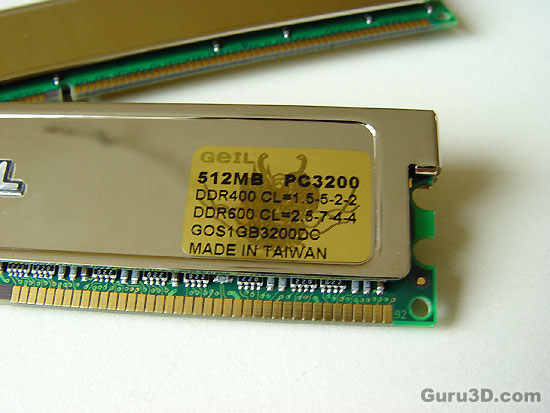Page 2
We'll start off with the regular A-B-C of memory. When you recently bought a PC, or for that matter are buying a new system you'll notice that most PC's make use of DDR400 (PC3200) memory. It's the most commonly used type as this memory matches your PC's CPU bus speed. That CPU bus speed, also known as "front-side bus speed" (or FSB), is the speed at which the CPU communicates with RAM memory and the motherboard chipset. Athlon XPs have a 266, 333 or 400 MHz FSB, Pentium 4s have a 400MHz, 533MHz or 800MHz and the newer 1066 MHz FSB, AMD Durons have a 200MHz FSB and socket 478 Celerons have a 400MHz FSB and so on and so on.
When choosing a FSB speed for the CPU you choose, be aware that you'll need to purchase memory capable of this faster speed. For example, many people are enticed by the remarkably low priced memory, yet you need to sync your memory to your CPU's FSB. First of all, all mainboard these days use either DDR or DDR2 memory, the mainboard we used needs DDR memory. So in our case we want to make make use of 400-533 MHz DDR memory if we are going to overclock (increase the FSB). Why all the way to DDR533? When you start fooling around with that FSB you better make sure you have some really good memory as the increased FSB will have a huge impact on the memory also.
Always make sure you buy two bars so that you can have a dual-channel memory configuration, which effectively double's the memory bandwidth. Pentium 4 for example loves that bandwidth for sure.
Performance and stability of any system depends in part on the memory being used and the settings for the RAM timing. Many users may have their preference for "123" brand and certainly using brand name memory is a very good idea since low quality memory is often at the root of many stability issues. However, it is also important to pay attention to the timing settings of the memory being used.
As stated on the previous page this memory was made for a particular user, probably the majority of Guru3D.com visitors (hey come on now you are reading this aren't you?). It's the enthusiast high-end user that will buy this kind of memory: tweakers, overclockers, you name it. The fact that it can manage such extremely fast timing tells us a little about its capacity to perform and thus it brings flexibility for the PC tweakers out there. And when I say extremely fast timings, I mean extremely fast. CAS (Column Address Strobe) 1.5, I don't think I've seen any other manufacturers out there bringing such fast memory to the market. Don't get me wrong though, Geil has got some excellent value series memory available also.
The Geil ONE Series TCCD version of memory modules are built using, and get this right, Hand-picked TCCD (32x8) DDR Chips running at PC3200 speeds, which translates to 400MHz DDR at CAS 1.5-2-2-5 or PC4800 (600MHz DDR) at CAS 2.5-4-4-7. You can buy this memory in a 512MB Single Package, 512MB (2X256MB) or 1GB (2x512MB) Dual Channel Kit Package which is the package we received. By the way, TCCD memory is of course made by Samsung. Samsung makes them with the aim to reach extreme clock speeds at slightly relaxed timings with much lower voltage requirements.
Specifications
- GeIL ONE hand-picked (TCCD) 32x8 DDR Chips 184-pin, Non-ECC, Un-buffered DDR DIMM Working Voltage 2.55V - 2.95V Platinum Copper Heatspreader Temperature Thermometer (not on the modules supplied?) Retail Package
- Lifetime Replacement Warranty
Told ya, the memory comes with a Lifetime Replacement Warranty, not bad at all huh?

